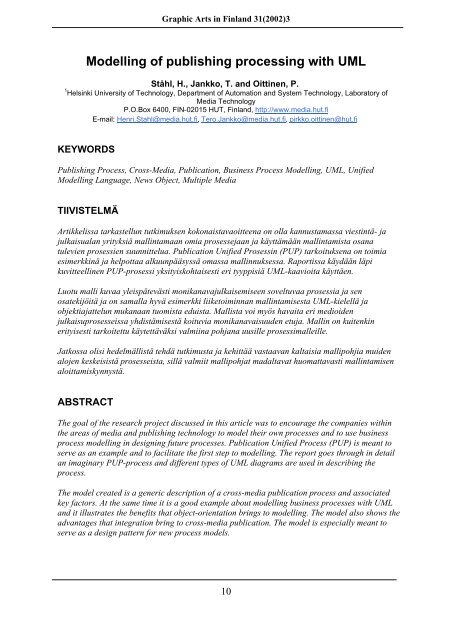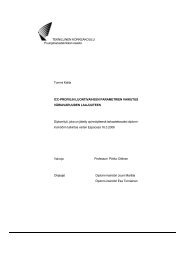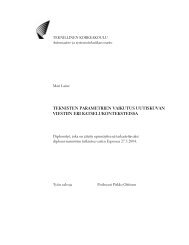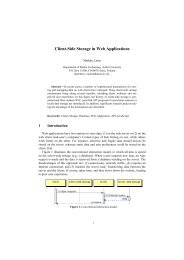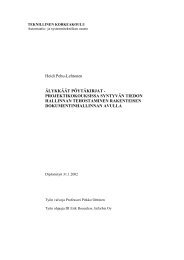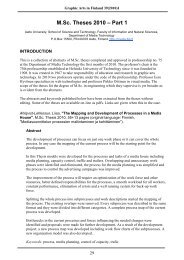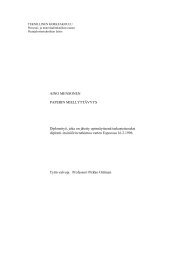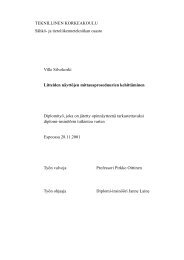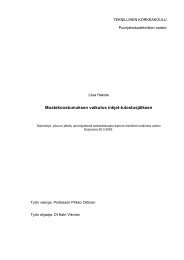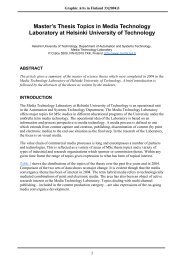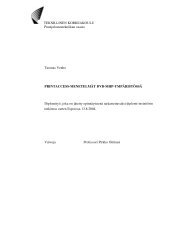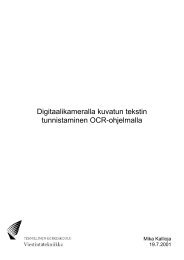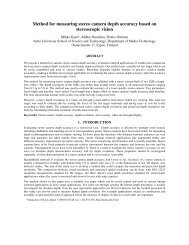Modelling of publishing processing with UML - CiteSeerX
Modelling of publishing processing with UML - CiteSeerX
Modelling of publishing processing with UML - CiteSeerX
You also want an ePaper? Increase the reach of your titles
YUMPU automatically turns print PDFs into web optimized ePapers that Google loves.
Graphic Arts in Finland 3 1 (200 2) 3<strong>Modelling</strong> <strong>of</strong> <strong>publishing</strong> <strong>processing</strong> <strong>with</strong> <strong>UML</strong>Ståhl, H., Jankko, T. and Oittinen, P.1 Helsinki University <strong>of</strong> Technology, Department <strong>of</strong> Automation and System Technology, Laboratory <strong>of</strong>Media TechnologyP.O.Box 6400, FIN-02015 HUT, Finland, http://www.media.hut.fiE-mail: Henri.Stahl@media.hut.fi, Tero.Jankko@media.hut.fi, pirkko.oittinen@hut.fiKEYWORDSPublishing Process, Cross- Media, Publication, Business Process <strong>Modelling</strong>, <strong>UML</strong>, Unified<strong>Modelling</strong> Language, News Object, Multiple MediaTIIVISTELMÄArtikkelissa tarkastellun tutkimuksen kokonaistavaoitteena on olla kannustamassa viestintä - jajulkaisualan yrityksiä mallintamaan omia prosessejaan ja käyttämään mallintamista osanatulevien prosessien suunnittelua. Publication Unified Prosessin (PUP) tarkoituksena on toimiaesimerkkinä ja helpottaa alkuunpääsyssä omassa mallinnuksessa. Raportissa käydään läpikuvitteellinen PUP- prosessi yksityiskohtaisesti eri tyyppisiä <strong>UML</strong>- kaavioita käyttäen.Luotu malli kuvaa yleispätevästi monikanavajulkaisemiseen soveltuvaa prosessia ja senosatekijöitä ja on samalla hyvä esimerkki liiketoiminnan mallintamisesta <strong>UML</strong>- kielellä jaobjektiajattelun mukanaan tuomista eduista. Mallista voi myös havaita eri medioidenjulkaisuprosesseissa yhdistämisestä koituvia monikanavaisuuden etuja. Mallin on kuitenkinerityisesti tarkoitettu käytettäväksi valmiina pohjana uusille prosessimalleille.Jatkossa olisi hedelmällistä tehdä tutkimusta ja kehittää vastaavan kaltaisia mallipohjia muidenalojen keskeisistä prosesseista, sillä valmiit mallipohjat madaltavat huomattavasti mallintamisenaloittamiskynnystä.ABSTRACTThe goal <strong>of</strong> the research project discussed in this article was to encourage the companies <strong>with</strong>inthe areas <strong>of</strong> media and <strong>publishing</strong> technology to model their own processes and to use businessprocess modelling in designing future processes. Publication Unified Process (PUP) is meant toserve as an example and to facilitate the first step to modelling. The report goes through in detailan imaginary PUP- process and different types <strong>of</strong> <strong>UML</strong> diagrams are used in desc ribing theprocess.The model created is a generic description <strong>of</strong> a cross - media publication process and associatedkey factors. At the same time it is a good example about modelling business processes <strong>with</strong> <strong>UML</strong>and it illustrates the benefits that object- o rientation brings to modelling. The model also shows theadvantages that integration bring to cross-media publication. The model is especially meant toserve as a design pattern for new process models.1 0
Graphic Arts in Finland 3 1 (200 2) 3Further research should be done in designing more des ign patterns for the essential businessprocesses in different area <strong>of</strong> business, because ready- made design patterns make the first step tobusiness modelling easier.INTRODUCTIONThe techniques and processes <strong>of</strong> information and media technology have undergon big changesduring the past ten years. The break - through <strong>of</strong> Internet brought possibilities like disseminatingdigital papers and hypertext documents around the world. Many traditional media houses haveexpanded their activities to Internet. For a long time the contents to different media have beenproduced separately, even in separate organisations <strong>with</strong>in a media house. In the 21st centurycross- media <strong>publishing</strong> has arisen and one and the same unit may produce content to differentmedia. Cross- media <strong>publishing</strong> brings along more complicated processes than in the pastandseveral new elements, like real- time <strong>publishing</strong>. Therefore designing and managing processes isboth economically and functionally much more challenging and important than before.The go al <strong>of</strong> the research was to encourage the companies <strong>with</strong>in the areas <strong>of</strong> media and <strong>publishing</strong>technology to use business process modelling while designing their processes. The diagramsproduced in this project are available via Internet and they are free to be reused and modified.Therefore they can help companies starting to model. <strong>Modelling</strong> the present state <strong>of</strong> ownprocesses <strong>with</strong> the help <strong>of</strong> the example diagrams, teaches also <strong>UML</strong> (Unified <strong>Modelling</strong>Language) and its use in business process modelling. Different modelling methods and tools wereconsidered in projects carried out in the Laboratory <strong>of</strong> Media Technology at the HelsinkiUniversity <strong>of</strong> Technology and finally <strong>UML</strong> was qualified as modelling method for this project.This article goes through the idea <strong>of</strong> improving business processes and the basics <strong>of</strong> <strong>UML</strong> inbusiness process modelling. On this basis, the PUP example process is introduced and the concept<strong>of</strong> the news object is examined. The full report can be reached in Finnish via URLhttp://www.media.hut. fi/GTTS/Suomi/dt&raportit/PUP/www_raportti.htm.TECHNICAL BACKGROUNDImproving Business ProcessesIt is <strong>of</strong>ten very useful to model a business process while trying to make improvements. <strong>Modelling</strong>gives a good overall picture about the process as a whole and its different phases. A thoroughunderstanding <strong>of</strong> the current processes helps creation <strong>of</strong> a vision about more productive and costeffectiveprocesses and find the steps to reach them.Business Process Re- engineering (BPR) is an effort to improve the productivity by creating betterbusiness processes. BPR proceeds <strong>of</strong>ten through the following five steps /12/:1 . Learn to understand the existing processes,2 . Model the processes,3 . Search the ways to improve the processes,4 . Create the future mo del (a model about the better future) and5 . Find the steps to achieve the better future.1 1
Graphic Arts in Finland 3 1 (200 2) 3Business Process <strong>Modelling</strong> MethodsThere are many different modelling methods and tools for business process modelling. Of thesethe Unified Modeling Language (<strong>UML</strong>) is one <strong>of</strong> the most promising. <strong>UML</strong> is an object- orientedmodelling language standardised by the Object Management Group (OMG) in 1997 /10/.Different companies have provided a huge amount <strong>of</strong> <strong>UML</strong> supporting tools, because <strong>UML</strong> is atotally independent stan dard. <strong>UML</strong> was originally designed for system and s<strong>of</strong>tware development/5/ and was later extended toward different areas <strong>of</strong> modelling, including business processmodelling /8/.By way <strong>of</strong> examples, <strong>UML</strong> has been used to modelling traffic systems. Because the complexity <strong>of</strong>the problems is arising Urban Traffic Systems designers are forced to use modelling approaches inorder to manage the design their systems, and to define and implement traffic managementstrategies. In this use <strong>UML</strong> has turned to be a very useful tool /1/. Second, <strong>UML</strong> has been used inthe insurance sector in the transformation to a process oriented organization. Based onreengineered business processes, a refocusing <strong>of</strong> the information system infrastructure was sought.<strong>UML</strong> and PROMET Business Process Re- engineering were used together. The conclusion wasthat the combination <strong>of</strong> <strong>UML</strong> and PROMET BPR produced the best results /2/.To be fair to the other modelling methods, IDEF0 has been used for <strong>publishing</strong> processesmodelling. First, In Helsin ki University <strong>of</strong> Technology had a project called Information Flow inNewsroom Processes. The object <strong>of</strong> the study was to model the newsroom process chain in a waywhich would make it possible to assess development needs from a technical viewpoint. As ac o n clusion, The IDEF0 model was found to <strong>of</strong>fer sufficient features for describing the newsroomwork flow. /9/TOOLSUnified Modeling LanguageThe notation <strong>of</strong> <strong>UML</strong> is clear and easy to learn. Therefore <strong>UML</strong> diagrams can be understood<strong>with</strong>out big efforts <strong>of</strong> study. The generally applicable <strong>UML</strong> diagrams fit well to many purposes.<strong>UML</strong> suites particularly to business process modelling, because <strong>UML</strong> supports well visualization<strong>of</strong> actions and activities. The processes can be divided in sub- processes and the important actionsor parts can be modelled in more detail. Additionally <strong>UML</strong> can present synchronisation andparallelism <strong>of</strong> actions and both human and IT - roles in collaboration. And object orientation incommon allows the models to be comprehensive, understandable, ch angeable, adaptable andreusable. /4/Different approaches to a process can be presented <strong>with</strong> nine different diagrams types <strong>of</strong> <strong>UML</strong>. Inbusiness process modelling the best applicable diagrams are Use Case, Activity and Classdiagrams, but also State, Sequence and Collaboration diagrams are very useful. /8/A Use Case diagram describes the actors, roles and activities. It has a simple and effectivenotation. It is especially applicable in describing process goals. A Class diagram presents insteadthe static structures and associations. A Class diagram is very versatile and it can also describevery complicated structures. It is good when used in forming entities and describing theirrelations.1 2
Graphic Arts in Finland 3 1 (200 2) 3Figure 1 P U P Main DiagramIn the use case diagrams <strong>of</strong> Figures 2 and 3, the news process is modelled starting <strong>with</strong> theoccurrence <strong>of</strong> a news item to its publication to a customer. These diagrams are sub-diagrams <strong>of</strong>the PUP use case in Figure 1.The Basis <strong>of</strong> the News Process (Figure 2) goes through the first steps <strong>of</strong> the process and the actorspossibly influencing the process. ‘News Gathering’ is about retrieving a news topic. It containsobservation <strong>of</strong> the sources <strong>of</strong> the news, the evaluation <strong>of</strong> the news topics found and the creation <strong>of</strong>the news object if the news topic is qualified. ‘Beginning the News Process’ includes choosing thewriter or the editors for the news item, determining the broadcasting channels and choosing thepoint <strong>of</strong> view. ‘Collecting Materials’ contains gathering the content and other channel -dependentmaterial for the story. Meta information is added to the material gathered and these are filed in thematerial archive (Figure 3). While filing, it is good to check the information formats immediatel yand change the format if it is incorrect. More material can be gathered later if needed.1 4
Graphic Arts in Finland 3 1 (200 2) 3Figure 2 The Basis <strong>of</strong> the News Process1 5
Graphic Arts in Finland 3 1 (200 2) 3Figure 3 Filing <strong>of</strong> the MaterialIn Figure 3 Filing <strong>of</strong> the Material includes the phases after the basis <strong>of</strong> the news process has beencreated. In ‘Writing story’ phase the story is written by using a cross- media assisting form, whichdefines the destination channels <strong>of</strong> the different parts <strong>of</strong> the text. The material found is gonethrough and used while writing. The story text is ready after checking the spelling and metainformation.‘Editing Story from Single to Cross- Media’ deals <strong>with</strong> editing the ready- made storysuitable to be published in another media.‘Lay outing <strong>of</strong> Story’ is considered as a phase <strong>of</strong> the PUP process that has potential to be highlyautomated and thereby the layouts for cross- media can be generated at once. Therefore it containsthe possibility to use layout- templates. By using templates the text and other edited material canbe fed to the publications <strong>with</strong> different layouts <strong>with</strong> just “a press <strong>of</strong> a button”. The alternative toautomatic layout is making manual layout. Making layout for the story is presented in a digram <strong>of</strong>its own (available via URL http://www.media.hut.fi/~th/PUP/layout_diagram.html).The use case ’Publishing’ (Figure <strong>of</strong> Publishing sub -diagram is available via URLhttp://www.media.hut.fi/~th/PUP/pub.html) is another part <strong>of</strong> the cross- media publication that canbe highly automated. In <strong>publishing</strong> a separation into two branches takes place: real- time updatednews and news updated as a whole. In <strong>publishing</strong> phase the stories <strong>with</strong> ready layouts are1 6
Graphic Arts in Finland 3 1 (200 2) 3published real- time or they are gathered into a single publication. Creating entities manually or ashighly automated as possible are both considered in the diagram. After the <strong>publishing</strong> phase thepublished product is ready in its final form and can be made accessible to the customer.Figure 4 The Editing PhaseThe News ObjectThe news process is modelled from the moment <strong>of</strong> a news event occurrence to the state where thenews is delivered to the customer. The news item is ready when it is finally ready for <strong>publishing</strong>.It is essential to model the development <strong>of</strong> a news item during the different phases <strong>of</strong> the process.For this purpose the concept <strong>of</strong> a news object /7/ was created.Creating a news object (Figure 5) means that an event has been chosen as a news item. Theeditorial staff creates a news object when it discovers an interesting and suitable topic for news. Inthe beginning, the news object is abstract and only a decision about creating a news item. Afterthat, the news object is edited to become a ready news item. While working <strong>with</strong> the news object,things are added to it. Therefore the model shows the concrete state <strong>of</strong> a news item during thedifferent phases <strong>of</strong> the process. The model also shows what has been done to the news item andwhat has to be done before it is ready to be published.1 7
Graphic Arts in Finland 3 1 (200 2) 3Figure 5 Sequence Diagram <strong>of</strong> The Creation and Preparation <strong>of</strong> the News ObjectFigure 5 presents the states following immediately the creation <strong>of</strong> the news object, that is selection<strong>of</strong> the publication channels. The channels must be chosen in cro ss- media <strong>publishing</strong>. After thepublication channels are chosen, the editors for the news item are chosen.The actors affecting the news object are presented in Figure 6. Naturally, most <strong>of</strong> the activitiessomehow deal <strong>with</strong> the news object during the news process, but some specifications need to bemade.1 8
Graphic Arts in Finland 3 1 (200 2) 3Figure 6 The Actors Influencing on the News ObjectThe editorial staff creates a news object and chooses a reporter for it. The point <strong>of</strong> view is chosenand it is added to the news object. The reporter searches for information and therefore goesthrough the archives <strong>of</strong> the editorial <strong>of</strong>fice and other sources <strong>of</strong> information and news. All therelevant material found is attached to the news object. The meta- information is always updatedwhen adding, removing or updating things to the news object.The reporter writes the story according to the material gathered by using a cross- media assistingform. Editors and the reporter edit and layout the rest <strong>of</strong> the material and unite it <strong>with</strong> the text.Finally, after spell checking and other corrections the news object has become a ready news item.The news item is either added to the publication object or published directly in case <strong>of</strong> real- timepublication. The ready news item is filed in the editorial <strong>of</strong>fice’s archives.1 9
Graphic Arts in Finland 3 1 (200 2) 3A new concept <strong>of</strong> ‘publication object’ was developed is this project. It is used like the newsobject, but it describes the phases <strong>of</strong> a publication received by the customer. The publication maybe for example a whole newspaper or a television broadcast.The creation <strong>of</strong> a publication begins <strong>with</strong> the creation <strong>of</strong> a publication object. The news items andpossible advertisements are added to the publication object, when they are ready. The layout ismade when all the material is gathered to the publication object. After the layout and necessarycorrections the publication object is ready to be filed and published in its media. At that time, thepublication object is ready.CONCLUSIONSThe model created is a generic description o f a cross-media publication process and its factors. Atthe same time it is an example about modelling business processes <strong>with</strong> <strong>UML</strong> and it illustrates thebenefits that object- orientation brings to modelling. The model facilitates the use <strong>of</strong> logical objectsin publication processes, such as news object and publication object. These objects can be used todescribe distinctly the development <strong>of</strong> a single news object and the whole publication in thedifferent phases <strong>of</strong> the publication process.The model is especially meant to serve as a design pattern for new process models. The diagrams<strong>of</strong> the model can be adjusted to fit own processes and then specified <strong>with</strong> more detailed subdiagrams.The diagrams can be simply adjusted <strong>with</strong> pen and paper or by downloading a diagramfile via URL http://www.media.hut.fi/~th/PUP/pup_final.mdl. The diagrams are in a file formatused by the Rational Rose. A free trial version <strong>of</strong> Rose has been available at Rational S<strong>of</strong>tw are’swebsite.The model shows also the advantages brought to cross - media publication by integration. Thereport describes the parts <strong>of</strong> the process that <strong>of</strong>fer possibilities for strong integration. Therefore themodel can be used as a guide while modifyin g own <strong>publishing</strong> processes towards cross- mediapublication.Further research should be done in designing more design patterns for the essential businessprocesses in different regions <strong>of</strong> business. This is pr<strong>of</strong>itable, because ready design patterns lowerth e first step to business modelling. Further research should be done also in finding the benefits <strong>of</strong>object- orientation in business process modelling.ACKNOWLEDGMENTSThe Publication Unified Process project was financed by GTTS which is gratefully acknowledged.2 0
Graphic Arts in Finland 3 1 (200 2) 3REFERENCES1 . Chabrol, M., Sarramia, D. Object Oriented Methodology Based on <strong>UML</strong> for urban Traffic System Modeling.In: Evans, A., Kent, S. Selic, B. (Eds). 2000 - The Unified Modeling Language: Advancing theStandard; Third Internation al Conference, York UK, October 2000 Proceedings. Germany 2000, Springer. P.4 2 5 - 4 3 9 .2 . Dietzsch, A. Adapting the <strong>UML</strong> to Business <strong>Modelling</strong>'s Needs - Experiences in Situational MethodEngineering. In: Jézéquel, J.-M., Hussmann, H., Cook, S. (Eds.). 2 0 0 2 - The Unified ModelingLanguage; Fifth International Conference, Dresden Germany, September 2002; Proceedings. Germany 2002,S p r i n g e r . P . 7 3 - 8 3 .3 . Eriksson, H., Penker, M. Business Modeling <strong>with</strong> <strong>UML</strong>. John Wiley & Sons, USA 2000. 459 p.4 . Fowler, M., S cott, K. <strong>UML</strong> distilled : applying the standard object modeling language. Addison-Wesley,Reading (MA), USA 1998. 179 p.5 . Jankko, T. The Basic <strong>of</strong> Publishing Technology 2 course's lecture slides 14.2.2002; Helsinki University <strong>of</strong>Technology, The Laboratory <strong>of</strong> Media Technology, Espoo 2002 [referred 21.11.2002]; Available at:6 . Jankko, T. <strong>UML</strong>-k a a v i o t - Notaatiot ja käyttö ver2.3. Helsinki University <strong>of</strong> Technology, The Laboratory <strong>of</strong>Media Technology, Espoo 2001 [referred 21.11.2002]7 . Jankko, T., Ståhl, H. News Process - Modelled <strong>with</strong> <strong>UML</strong>. Helsinki University <strong>of</strong> Technology, The Laboratory<strong>of</strong> Media Technology, Espoo 2000. 25p.8 . N o r a n , O . Business <strong>Modelling</strong>: <strong>UML</strong> vs. IDEF. Griffith University, School <strong>of</strong> Computing and InformationTechnology, Griffith 2000. CIT 6114. 50 p. Available at:9 . Oittinen, P., Akkanen, M., Hopiavaara, R., Muukka, H. Sanomalehtien uutistoimitusten toimintaprosessienkuvaaminen informaatioketjun kannalta (Information Flow in Newsroom Processes). Helsinki University <strong>of</strong>Technology, The Laboratory <strong>of</strong> Media Technology, Espoo 2000. Loppuraportti. 11 p.1 0 . OMG. Unified Modeling Language (<strong>UML</strong>), version 1.4. OMG, updated 21.1.2002 [referred 21.11.2002];A v a i l a b l e a t : 1 1 . Peltonen, J. The Basic <strong>of</strong> Publishing Technology 2 course's lecture slides 8.3.2001. Helsinki University <strong>of</strong>Technology, Espoo 2001, updated 8.3.2001 [referred 21.11.2002]. Available at:1 2 . Savolainen, T., Saaren -Seppälä, K., Savolainen, S. Liiketoimintaprosessien luova virtaviivaistaminen.Metalliteollisuuden kustannus, Helsinki 1997. 199 p.2 1


